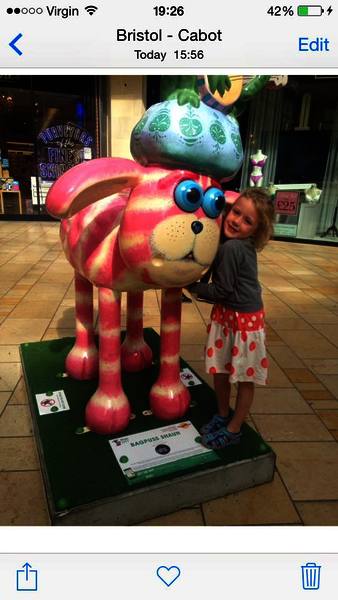Items where Year is 2016
 | Up a level |
Number of items: 430.
-
-
Reflection Framework - feedbackExpanding the framework for reflection
Shared with the World byDr Su White -
Open data: Getting more value from data you already haveSlides for my talk at the CHEAD Membership & Networking Meeting
Shared with the World byMr Christopher Gutteridge -
WEBS2002 Group Projects: What can Flickr photographs tell us about New York City?In their second year, our undergraduate web scientists undertake a group project module (WEBS2002, taught by Jonathon Hare & Su White) in which they get to apply what they learnt in the first year to a practical web-science problem, and also learn about team-working. For the project this semester, the students were provided with a large dataset of geolocated images and associated metadata collected from the Flickr website. Using this data, they were tasked with exploring what this data could tell us about New York City. In this seminar the two groups will present the outcomes of their work. Team Alpha (Thomas Davidson, Adam Rann, Luke Gibbins & Ryan Dodd) will present their work on “Analysing Flickr Demographics: Identifying Optimal Advertising Locations in New York". This work aims to detect areas of high footfall for varying demographics with the aim of using this information to more accurately target advertising. Team Bravo (Thomas Rowledge, Xavier Voigt-Hill & Chloe Cripps) will present their work on “The Flickr that Never Sleeps: Observing a Changing City Through a Decade of Geotagged Uploads". This work aims to explore the broad breadth of ways in which users' interactions with Flickr captures reactions, geographical trends and the changing picture of a prominent global city.
Shared with the University byMs Amber Bu -
From researcher to entrepreneur - my experience to commercialise SynoteIn this seminar, I will share my experience in the early process of becoming an entrepreneur from a research background. Since 2008, I have been working with Prof. Mike Wald on an innovative video annotation tool called Synote. After about eight years of research around Synote, I have applied for the Royal Acadamy of Engineering Enterprise Fellowship in order to focus on developing Synote for real clients and making Synote sustainable and profitable. Now, it is already eight months into the fellowship, which has totally changed my life. It is very exciting, but at the same time I'm struggling all the time. The seminar will briefly go through my experience so far on the way of commercializing Synote from a research background. I will also discuss the valuable resources you can get from RAEng Enterprise Hub and Future Worlds, which is a Southampton based organization to help startups. If you are a Ph.D. student or research fellow in the University, and you want to start your own business, this is the seminar you want to attend.
Shared with the University byMr Roushdat Elaheebocus -
Web Science Guest Lectures 2016Latest set of lectures from 2016
Shared with the World byProf Leslie Carr -
Introduction to EdSharePresentation slides used in my online webinar session at ALTC 2016 Online Winter Conference. Providing an introduction to EdShare, the open source OER sharing platform from the University of Southampton. Discussion around its core features as well as the future development roadmap. Link to webinar recording will be added shortly.
Shared with the World byMrs Kelly Terrell -
Data Visualisation: Other data visualisation tools and Twitter data
Shared with the University byDr Elena Demidova -
-
-
-
-
-
-
-
-
-
-
-
-
-
-
-
-
-
-
-
-
-
-
-
-
-
WEB6203 Interdisciplinary Thinking: Poster Mark sheetMarking criteria for the poster assignment
Shared with the World byDr Su White -
-
Technical report: abstract guidance and research processguidance drafting and redrafting the abstract while building your report contents
Shared with the World byDr Su White -
-
-
Online Tool to Create Simple Graphs in D3 - Raw
Shared with the University byDr Christopher Phethean -
Approaches to using visualisations to tell stories
Shared with the University byDr Christopher Phethean -
-
-
-
-
-
-
Technical report: example cheats!work in progress - technical report rules and cheats
Shared with the World byDr Su White -
bad LD terms small and fasterbad LD terms small and faster animation
Shared with the University byMr John Savage -
Technical report - basic templateBasic template to be followed when completing the technical report coursework for COMP1205.
Shared with the University byDr Jian Shi -
-
Lecture on Confidence Intervals and Relationship between variables
Shared with the University byDr Markus Brede -
COMP6234 Group CW - Extra Information and Tips
Shared with the University byDr Christopher Phethean -
Technical writingSlides for technical writing. See also notes on ECS module pages
Shared with the World byDr Jian Shi -
Acknowledging ownership: ethical behaviour & academic integritySlides for Academic Integrity. See also notes on ECS module page
Shared with the World byDr Jian Shi -
bad terms for LD small versionbad terms for LD dissolve in and out small version
Shared with the University byMr John Savage -
bad terms for LDseries of dissolves of bad terms for LD
Shared with the University byMr John Savage -
Interactive graphics and advanced storytellingLectures on COMP6234
Shared with the University byProf Elena Simperl -
-
-
D3 Tutorial 3For the first part of the tutorial, use results.csv. For the second part use the CPI_October file.
Shared with the University byDr Christopher Phethean -
-
Wolfensberger perjorative termsThis is a little animation that seeks to inform the reader of Wolfensberger 6 perjorative terms
Shared with the University byMr John Savage -
Environmental sensing with the Internet of ThingsAbstract: After developing many sensor networks using custom protocols to save energy and minimise code complexity - we have now experimented with standards-based designs. These use IPv6 (6LowPAN), RPL routing, Coap for interfaces and data access and protocol buffers for data encapsulation. Deployments in the Cairngorm mountains have shown the capabilities and limitations of the implementations. This seminar will outline the hardware and software we used and discuss the advantages of the more standards-based approach. At the same time we have been progressing with high quality imaging of cultural heritage using the RTIdomes - so some results and designs will be shown as well. So this seminar will cover peat-bogs to museums, binary-HTTP-like REST to 3500 year old documents written on clay.
Shared with the University byMr Roushdat Elaheebocus -
-
-
In search of a social science research methods pedagogy for the digital era: the story so farPresentation given at the 2016 British Educational Research Association (BERA) conference
Shared with the World byMs Debbie Collins -
-
-
-
-
-
-
Graduation Marshalling_Nuffield2015-2016 1280x720 with resize screen option
Shared with the University byMs Mimi Lee -
-
-
-
Data scienceGuest lecture COMP1205, fundamentals and applications of data science
Shared with the University byProf Elena Simperl -
-
-
-
-
-
-
-
COMP6234 Week 6Visual perception, information design for the brain, discussion of good and bad visualisations
Shared with the University byProf Elena Simperl -
-
COMP1205: Focus on languageNotes based on discussions with students for whom English is not their first language. Relevant generally and specifically in preparation of the group presenatations
Shared with the World byDr Su White -
Visualising interdisciplinarityHow you might use visualisations as a model. References Bastow, S., Dunleavy, P., & Tinkler, J. (2014). The impact of the social sciences: how academics and their research make a difference. Sage.
Shared with the World byDr Su White -
-
-
-
-
-
-
-
-
Web Knowledge and Web Governance: WAIS PhD Research ReportsAbstract This seminar consists of two very different research reports by PhD students in WAIS. Hypertext Engineering, Fettling or Tinkering (Mark Anderson): Contributors to a public hypertext such as Wikipedia do not necessarily record their maintenance activities, but some specific hypertext features - such transclusion - could indicate deliberate editing with a mind to the hypertext’s long-term use. The MediaWiki software used to create Wikipedia supports transclusion, a deliberately hypertextual form of content creation which aids long terms consistency. This discusses the evidence of the use of hypertext transclusion in Wikipedia, and its implications for the coherence and stability of Wikipedia. Designing a Public Intervention - Towards a Sociotechnical Approach to Web Governance (Faranak Hardcastle): In this talk I introduce a critical and speculative design for a socio-technical intervention -called TATE (Transparency and Accountability Tracking Extension)- that aims to enhance transparency and accountability in Online Behavioural Tracking and Advertising mechanisms and practices.
Shared with the University byMr Roushdat Elaheebocus -
Mandevillian Intelligence: From Individual Vice to Collective VirtueAbstract Mandevillian intelligence is a specific form of collective intelligence in which individual cognitive vices (i.e., shortcomings, limitations, constraints and biases) are seen to play a positive functional role in yielding collective forms of cognitive success. In this talk, I will introduce the concept of mandevillian intelligence and review a number of strands of empirical research that help to shed light on the phenomenon. I will also attempt to highlight the value of the concept of mandevillian intelligence from a philosophical, scientific and engineering perspective. Inasmuch as we accept the notion of mandevillian intelligence, then it seems that the cognitive and epistemic value of a specific social or technological intervention will vary according to whether our attention is focused at the individual or collective level of analysis. This has a number of important implications for how we think about the cognitive impacts of a number of Web-based technologies (e.g., personalized search mechanisms). It also forces us to take seriously the idea that the exploitation (or even the accentuation!) of individual cognitive shortcomings could, in some situations, provide a productive route to collective forms of cognitive and epistemic success. Speaker Biography Dr Paul Smart Paul Smart is a senior research fellow in the Web and Internet Science research group at the University of Southampton in the UK. He is a Fellow of the British Computer Society, a professional member of the Association of Computing Machinery, and a member of the Cognitive Science Society. Paul’s research interests span a number of disciplines, including philosophy, cognitive science, social science, and computer science. His primary area of research interest relates to the social and cognitive implications of Web and Internet technologies. Paul received his bachelors degree in Psychology from the University of Nottingham. He also holds a PhD in Experimental Psychology from the University of Sussex.
Shared with the University byMr Roushdat Elaheebocus -
Data Science Seminar: The data science revolution in Physics and AstronomyAbstract Heading into the 2020s, Physics and Astronomy are undergoing experimental revolutions that will reshape our picture of the fabric of the Universe. The Large Hadron Collider (LHC), the largest particle physics project in the world, produces 30 petabytes of data annually that need to be sifted through, analysed, and modelled. In astrophysics, the Large Synoptic Survey Telescope (LSST) will be taking a high-resolution image of the full sky every 3 days, leading to data rates of 30 terabytes per night over ten years. These experiments endeavour to answer the question why 96% of the content of the universe currently elude our physical understanding. Both the LHC and LSST share the 5-dimensional nature of their data, with position, energy and time being the fundamental axes. This talk will present an overview of the experiments and data that is gathered, and outlines the challenges in extracting information. Common strategies employed are very similar to industrial data! Science problems (e.g., data filtering, machine learning, statistical interpretation) and provide a seed for exchange of knowledge between academia and industry. Speaker Biography Professor Mark Sullivan Mark Sullivan is a Professor of Astrophysics in the Department of Physics and Astronomy. Mark completed his PhD at Cambridge, and following postdoctoral study in Durham, Toronto and Oxford, now leads a research group at Southampton studying dark energy using exploding stars called "type Ia supernovae". Mark has many years' experience of research that involves repeatedly imaging the night sky to track the arrival of transient objects, involving significant challenges in data handling, processing, classification and analysis.
Shared with the University byMr Roushdat Elaheebocus -
Social machines dictating social behaviors – When context is missing what is the fallout of uberveillance?Abstract: In the mid-1990s when I worked for a telecommunications giant I struggled to gain access to basic geodemographic data. It cost hundreds of thousands of dollars at the time to simply purchase a tile of satellite imagery from Marconi, and it was often cheaper to create my own maps using a digitizer and A0 paper maps. Everything from granular administrative boundaries to right-of-ways to points of interest and geocoding capabilities were either unavailable for the places I was working in throughout Asia or very limited. The control of this data was either in a government’s census and statistical bureau or was created by a handful of forward thinking corporations. Twenty years on we find ourselves inundated with data (location and other) that we are challenged to amalgamate, and much of it still “dirty” in nature. Open data initiatives such as ODI give us great hope for how we might be able to share information together and capitalize not only in the crowdsourcing behavior but in the implications for positive usage for the environment and for the advancement of humanity. We are already gathering and amassing a great deal of data and insight through excellent citizen science participatory projects across the globe. In early 2015, I delivered a keynote at the Data Made Me Do It conference at UC Berkeley, and in the preceding year an invited talk at the inaugural QSymposium. In gathering research for these presentations, I began to ponder on the effect that social machines (in effect, autonomous data collection subjects and objects) might have on social behaviors. I focused on studying the problem of data from various veillance perspectives, with an emphasis on the shortcomings of uberveillance which included the potential for misinformation, misinterpretation, and information manipulation when context was entirely missing. As we build advanced systems that rely almost entirely on social machines, we need to ponder on the risks associated with following a purely technocratic approach where machines devoid of intelligence may one day dictate what humans do at the fundamental praxis level. What might be the fallout of uberveillance? Bio: Dr Katina Michael is a professor in the School of Computing and Information Technology at the University of Wollongong. She presently holds the position of Associate Dean – International in the Faculty of Engineering and Information Sciences. Katina is the IEEE Technology and Society Magazine editor-in-chief, and IEEE Consumer Electronics Magazine senior editor. Since 2008 she has been a board member of the Australian Privacy Foundation, and until recently was the Vice-Chair. Michael researches on the socio-ethical implications of emerging technologies with an emphasis on an all-hazards approach to national security. She has written and edited six books, guest edited numerous special issue journals on themes related to radio-frequency identification (RFID) tags, supply chain management, location-based services, innovation and surveillance/ uberveillance for Proceedings of the IEEE, Computer and IEEE Potentials. Prior to academia, Katina worked for Nortel Networks as a senior network engineer in Asia, and also in information systems for OTIS and Andersen Consulting. She holds cross-disciplinary qualifications in technology and law.
Shared with the University byMr Roushdat Elaheebocus -
Enabling Provenance on the Web: Standardization and Research QuestionsProvenance is a record that describes the people, institutions, entities, and activities, involved in producing, influencing, or delivering a piece of data or a thing in the world. Some 10 years after beginning research on the topic of provenance, I co-chaired the provenance working group at the World Wide Web Consortium. The working group published the PROV standard for provenance in 2013. In this talk, I will present some use cases for provenance, the PROV standard and some flagship examples of adoption. I will then move on to our current research area aiming to exploit provenance, in the context of the Sociam, SmartSociety, ORCHID projects. Doing so, I will present techniques to deal with large scale provenance, to build predictive models based on provenance, and to analyse provenance.
Shared with the University byMr Roushdat Elaheebocus -
-
-
The MOOC Dashboard: Visualising MOOC data for everyoneAbstract Massive Open Online Courses (MOOCs) generate enormous amounts of data. The University of Southampton has run and is running dozens of MOOC instances. The vast amount of data resulting from our MOOCs can provide highly valuable information to all parties involved in the creation and delivery of these courses. However, analysing and visualising such data is a task that not all educators have the time or skills to undertake. The recently developed MOOC Dashboard is a tool aimed at bridging such a gap: it provides reports and visualisations based on the data generated by learners in MOOCs. Speakers Manuel Leon is currently a Lecturer in Online Teaching and Learning in the Institute for Learning Innovation and Development (ILIaD). Adriana Wilde is a Teaching Fellow in Electronics and Computer Science, with research interests in MOOCs and Learning Analytics. Darron Tang (4th Year BEng Computer Science) and Jasmine Cheng (BSc Mathematics & Actuarial Science and starting MSc Data Science shortly) have been working as interns over this Summer (2016) as have been developing the MOOC Dashboard.
Shared with the World byMr Roushdat Elaheebocus -
WEBS6203 Feedback on AbstractSpreadsheet of abstracts with comments plus note of general comments applying to whole set. You have to download the spreadsheet to be able to read its contents. Only visible with university login
Shared with the University byDr Su White -
Room for Writing: moving from abstract to extended abstractAn developmental exercise to help grow the superstructure of a report. A paper by Repko discussing common ground is included, if you are looking at interdisciplinarity, you are also advised to look at the set text, Chapter 11, Page 271 (1st edition) Ch 11 & 12 from Page 321 (2nd edition)
Shared with the World byDr Su White -
Decisions, decisions everywhere (in the open data era).Abstract: Decision support systems have been widely used for years in companies to gain insights from internal data, thus making successful decisions. Lately, thanks to the increasing availability of open data, these systems are also integrating open data to enrich decision making process with external data. On the other hand, within an open-data scenario, decision support systems can be also useful to decide which data should be opened, not only by considering technical or legal constraints, but other requirements, such as "reusing potential" of data. In this talk, we focus on both issues: (i) open data for decision making, and (ii) decision making for opening data. We will first briefly comment some research problems regarding using open data for decision making. Then, we will give an outline of a novel decision-making approach (based on how open data is being actually used in open-source projects hosted in Github) for supporting open data publication. Bio of the speaker: Jose-Norberto Mazón holds a PhD from the University of Alicante (Spain). He is head of the "Cátedra Telefónica" on Big Data and coordinator of the Computing degree at the University of Alicante. He is also member of the WaKe research group at the University of Alicante. His research work focuses on open data management, data integration and business intelligence within "big data" scenarios, and their application to the tourism domain (smart tourism destinations). He has published his research in international journals, such as Decision Support Systems, Information Sciences, Data & Knowledge Engineering or ACM Transaction on the Web. Finally, he is involved in the open data project in the University of Alicante, including its open data portal at http://datos.ua.es
Shared with the University byMr Roushdat Elaheebocus -
COMP6235 Coursework 1The Jupyter Notebook for the first coursework.
Shared with the University byMr Huw Fryer -
-
-
Disciplinary differences: a flying visit W1: taking an interdisciplinary approachOverview of disciplinary differences taking a web science perspective as a starting point.
Shared with the World byDr Su White -
COMP1205 Lecture 3.3How to write abstracts - and get your audience interested See also notes on ECS module page: https://secure.ecs.soton.ac.uk/module/1617/COMP1205/33423/
Shared with the World byDr Su White -
-
-
-
-
-
-
-
-
Prepare for the ITSE Fair 2016Slide presentation for FPSE students
Shared with the University byMs Joyce Lewis -
-
-
Tableau Workbook 1The workbook contains everything up until the end of Tutorial 2. You can use it if you need to work through Tutorial 2 but don't have your saved file available from last week.
Shared with the University byDr Christopher Phethean -
-
Social Construction of Technology (SCOT) lecture slidesSCOT lecture slides for Foundations in Web Science
Shared with the University byMrs Lynn Oloro -
Business model in accountingBusiness model in accounting
Shared with the University byMiss Danni Zheng -
Room for Writing: How to write an abstractAn introductory guide to writing abstracts Includes background, references and further reading
Shared with the World byDr Su White -
-
-
Room for Writing: Automatic note takingAn introductory exercise to practice when reading papers. May be useful if you are preparing for a reading group meeting.
Shared with the World byDr Su White -
WEB6203 Interdisciplinary Thinking: Poster AssignmentDetailed description of the assignment
Shared with the World byDr Su White -
-
-
COMP6235 Introduction and fundamentals (II)Fundamentals of data science and introduction to COMP6235 (continued)
Shared with the University byProf Elena Simperl -
-
-
-
-
-
-
-
-
-
-
Interdisciplinary Thinking: Clarifications and beginningsSlides and tasks Introductory sessions
Shared with the World byDr Su White -
CV and online presenceHow to write your resume, how to manage your online brand, instructions 1st coursework
Shared with the University byProf Elena Simperl -
Guest Talk and Tutorial 1: Assessment and coursework in COMP6235
Shared with the University byDr Christopher Phethean -
COMP6234 Week 1Introduction to the module, fundamentals, history of data visualisation
Shared with the University byProf Elena Simperl -
COMP6235 Introduction and fundamentals (I)Fundamentals of data science and introduction to COMP6235
Shared with the University byProf Elena Simperl -
COMP1205 CW1 instructionsInstructions for the CV coursework
Shared with the University byProf Elena Simperl -
COMP1205 self-assessment template CVAppendix needed for the CV coursework.
Shared with the University byProf Elena Simperl -
W1: taking an interdisciplinary approachOverview of the module from the interdisciplinary writing perspective. Using posters from web science research, discuss and consider what you might scope as an inter-deisciplinary project
Shared with the World byDr Su White -
COMP1205 Lecture 1.1Introduction and Welcome. See also notes on ECS module page: https://secure.ecs.soton.ac.uk/module/1920/COMP1205/
Shared with the World byDr Su White -
Assignment 2 Part 2 InstructionsResources created at the University of Southampton for the module Remote Sensing for Earth Observation
Shared with the World byMr Luke Brown -
MSc Thesis - Discoverability Strategies for Open Educational Resources: A Scoping StudyWith an early focus on achieving a critical mass of released open educational content, challenges of how resources can be found by beneficiaries has been highlighted as a major issue. As we move forward further research and investigation is required to understand the most effective approaches of reaching out to and engaging a globally dispersed population of education users. In 2014 I conducted a small scale scoping study into the discoverability strategies identified as being used by higher education institutions releasing OERs in the UK. This was mapped against a body of literature on our understanding of user behaviour for online resource discovery and the technologies available to support this to identify trends and gaps as opportunities for improvements. Please note this report was not originally written for publication. I hope however it is of value to the open education community and will act as a starting point for further research in this area.
Shared with the World byMrs Kelly Terrell -
-
Hierarchy v typology of evidenceHierarchy v typology of evidence animation
Shared with the University byMr John Savage -
Methodology for Literature reviewMethodology for Literature review
Shared with the World byMr John Savage -
-
Route through project plan no resumeRoute through project plan no resume
Shared with the University byMr John Savage -
Route through Dissertation plan mapThis map describes the stages of planning your route through an MSc dissertation
Shared with the University byMr John Savage -
Control Loop2Control Loop for project management of MSc dissertation
Shared with the World byMr John Savage -
Control LoopDescribes project management control loop for managing an MSc dissertation
Shared with the University byMr John Savage -
-
-
Repositories for open education and improving discoverability of OERsPresentation given at 2016 Association for Learning Technology conference at University of Warwick (ALT2016). This presentation shares key findings from my MSc thesis on discoverability strategies for OERs after a small scale study into Jisc UKOER projects. The origins, key features and recent improvements to EdShare, the OER repository solution which is available through EPrints Services at the University of Southampton, is highlighted. Repositories provide an excellent way of archiving, preserving and managing content, but is this enough for OERs. OERs are about more than simply sharing, and this presentation highlighted a number of development areas under consideration for EdShare, to become a more open digital space.
Shared with the World byMrs Kelly Terrell -
Literature review processLiterature review process reworded under instruction from Dr P white
Shared with the World byMr John Savage -
Assignment 2 Part 1 InstructionsResources created at the University of Southampton for the module Remote Sensing for Earth Observation
Shared with the World byMr Luke Brown -
Assignment 2 Part 1 DataResources created at the University of Southampton for the module Remote Sensing for Earth Observation
Shared with the World byMr Luke Brown -
Assignment 2 Part 2 DataResources created at the University of Southampton for the module Remote Sensing for Earth Observation
Shared with the World byMr Luke Brown -
Assignment 3 DataResources created at the University of Southampton for the module Remote Sensing for Earth Observation
Shared with the World byMr Luke Brown -
-
Types of evidenceThis is a looping animation that shows different types of evidence for the dissertation.
Shared with the World byMr John Savage -
Climate Change and MalariaResources created at the University of Southampton for the module Remote Sensing for Earth Observation
Shared with the World byMr Luke Brown -
Floods and EarthquakesResources created at the University of Southampton for the module Remote Sensing for Earth Observation
Shared with the World byMr Luke Brown -
-
-
-
-
-
-
-
-
-
-
-
-
-
-
-
-
-
-
-
-
-
-
-
-
-
-
-
-
-
-
-
-
-
-
-
-
-
-
-
-
-
-
-
Supervised ClassificationResources created at the University of Southampton for the module Remote Sensing for Earth Observation
Shared with the World byMr Luke Brown -
ISODATA ClassificationResources created at the University of Southampton for the module Remote Sensing for Earth Observation
Shared with the World byMr Luke Brown -
K-means ClassificationResources created at the University of Southampton for the module Remote Sensing for Earth Observation
Shared with the World byMr Luke Brown -
MERIS Terrestrial Chlorophyll IndexResources created at the University of Southampton for the module Remote Sensing for Earth Observation
Shared with the World byMr Luke Brown -
Enhanced Vegetation IndexResources created at the University of Southampton for the module Remote Sensing for Earth Observation
Shared with the World byMr Luke Brown -
Normalised Difference Vegetation IndexResources created at the University of Southampton for the module Remote Sensing for Earth Observation
Shared with the World byMr Luke Brown -
Soil Line and Simple RatioResources created at the University of Southampton for the module Remote Sensing for Earth Observation
Shared with the World byMr Luke Brown -
Vegetation IndicesResources created at the University of Southampton for the module Remote Sensing for Earth Observation
Shared with the World byMr Luke Brown -
Earth Surface PropertiesResources created at the University of Southampton for the module Remote Sensing for Earth Observation
Shared with the World byMr Luke Brown -
Digital Image EnhancementResources created at the University of Southampton for the module Remote Sensing for Earth Observation
Shared with the World byMr Luke Brown -
High Pass FiltersResources created at the University of Southampton for the module Remote Sensing for Earth Observation
Shared with the World byMr Luke Brown -
Low Pass FiltersResources created at the University of Southampton for the module Remote Sensing for Earth Observation
Shared with the World byMr Luke Brown -
Georectification in EnviResources created at the University of Southampton for the module Remote Sensing for Earth Observation
Shared with the World byMr Luke Brown -
Resampling MethodsResources created at the University of Southampton for the module Remote Sensing for Earth Observation
Shared with the World byMr Luke Brown -
SMAC Atmopsheric CorrectionResources created at the University of Southampton for the module Remote Sensing for Earth Observation
Shared with the World byMr Luke Brown -
Dark Object SubtractionResources created at the University of Southampton for the module Remote Sensing for Earth Observation
Shared with the World byMr Luke Brown -
Introduction to EnviResources created at the University of Southampton for the module Remote Sensing for Earth Observation
Shared with the World byMr Luke Brown -
Contrast Stretch DataResources created at the University of Southampton for the module Remote Sensing for Earth Observation
Shared with the World byMr Luke Brown -
Radiometric CalibrationResources created at the University of Southampton for the module Remote Sensing for Earth Observation
Shared with the World byMr Luke Brown -
Missing Scan LineResources created at the University of Southampton for the module Remote Sensing for Earth Observation
Shared with the World byMr Luke Brown -
Image HistogramsResources created at the University of Southampton for the module Remote Sensing for Earth Observation
Shared with the World byMr Luke Brown -
Colour DisplayResources created at the University of Southampton for the module Remote Sensing for Earth Observation
Shared with the World byMr Luke Brown -
What is a Digital Image?Resources created at the University of Southampton for the module Remote Sensing for Earth Observation
Shared with the World byMr Luke Brown -
MERISResources created at the University of Southampton for the module Remote Sensing for Earth Observation
Shared with the World byMr Luke Brown -
SPOT DEMResources created at the University of Southampton for the module Remote Sensing for Earth Observation
Shared with the World byMr Luke Brown -
-
-
-
-
-
-
-
-
-
-
-
-
Graduation Marshalling Nuffield 2015Online resource for volunteer marshalls for Graduation ceromony
Shared with the University byMs Mimi Lee -
MSS vs TMResources created at the University of Southampton for the module Remote Sensing for Earth Observation
Shared with the World byMr Luke Brown -
EMR Interaction with WaterResources created at the University of Southampton for the module Remote Sensing for Earth Observation
Shared with the World byMr Luke Brown -
Water Colour KMZResources created at the University of Southampton for the module Remote Sensing for Earth Observation
Shared with the World byMr Luke Brown -
EMR Interaction with WaterResources created at the University of Southampton for the module Remote Sensing for Earth Observation
Shared with the World byMr Luke Brown -
-
-
-
-
-
Spectral Properties of VegetationResources created at the University of Southampton for the module Remote Sensing for Earth Observation
Shared with the World byMr Luke Brown -
-
Spectral Signature Activity DataResources created at the University of Southampton for the module Remote Sensing for Earth Observation
Shared with the World byMr Luke Brown -
Radiant EnergyResources created at the University of Southampton for the module Remote Sensing for Earth Observation
Shared with the World byMr Luke Brown -
Electromagnetic EnergyResources created at the University of Southampton for the module Remote Sensing for Earth Observation
Shared with the World byMr Luke Brown -
Coastal Question KMLResources created at the University of Southampton for the module Remote Sensing for Earth Observation
Shared with the World byMr Luke Brown -
UNEP One Planet Many PeopleResources created at the University of Southampton for the module Remote Sensing for Earth Observation
Shared with the World byMr Luke Brown -
NT CADCAM Webinar - SOLIDWORKS PDM for managing SOLIDWORKS dataCopy of NT CADCAM Webinar (~Q1 2016) - Managing SOLIDWORKS data with SOLIDWORKS PDM, provided for reference in FEE by Max Templeman, Account Manager for NT CADCAM Ltd
Shared with the University byDr Tim Woolman -
-
-
-
-
-
-
-
-
Data Science Seminar: Generic Big Data Processing for Advancing Situation Awareness and Decision-SupportThe generation of heterogeneous big data sources with ever increasing volumes, velocities and veracities over the he last few years has inspired the data science and research community to address the challenge of extracting knowledge form big data. Such a wealth of generated data across the board can be intelligently exploited to advance our knowledge about our environment, public health, critical infrastructure and security. In recent years we have developed generic approaches to process such big data at multiple levels for advancing decision-support. It specifically concerns data processing with semantic harmonisation, low level fusion, analytics, knowledge modelling with high level fusion and reasoning. Such approaches will be introduced and presented in context of the TRIDEC project results on critical oil and gas industry drilling operations and also the ongoing large eVacuate project on critical crowd behaviour detection in confined spaces.
Shared with the University byMr Roushdat Elaheebocus -
-
-
-
Oceans Deep: Lesson C (Floating and sinking)Teacher resources for Lesson C in the Discover Oceanography 'Scheme of Work' for use in schools. Contains materials sourced under a CC BY SA license from the TES website.
Shared with the World byDr Sarah Fielding -
Oceans Deep: Lesson E (Plankton Police)Teacher resources for Lesson E in the Discover Oceanography 'Scheme of Work' for use in schools.
Shared with the World byDr Sarah Fielding -
-
Macrobenthic assemblages (Fish Farm)Demo version of Macrobenthic assemblages
Shared with the University byMs Mimi Lee -
-
-
-
-
-
-
It's always been about the linksAbstract The World Wide Web Consortium, W3C, is known for standards like HTML and CSS but there's a lot more to it than that. Mobile, automotive, publishing, graphics, TV and more. Then there are horizontal issues like privacy, security, accessibility and internationalisation. Many of these assume that there is an underlying data infrastructure to power applications. In this session, W3C's Data Activity Lead, Phil Archer, will describe the overall vision for better use of the Web as a platform for sharing data and how that translates into recent, current and possible future work. What's the difference between using the Web as a data platform and as a glorified USB stick? Why does it matter? And what makes a standard a standard anyway? Speaker Biography Phil Archer Phil Archer is Data Activity Lead at W3C, the industry standards body for the World Wide Web, coordinating W3C's work in the Semantic Web and related technologies. He is most closely involved in the Data on the Web Best Practices, Permissions and Obligations Expression and Spatial Data on the Web Working Groups. His key themes are interoperability through common terminology and URI persistence. As well as work at the W3C, his career has encompassed broadcasting, teaching, linked data publishing, copy writing, and, perhaps incongruously, countryside conservation. The common thread throughout has been a knack for communication, particularly communicating complex technical ideas to a more general audience.
Shared with the University byMr Roushdat Elaheebocus -
Why Cyber Security is HardAbstract There has been a great deal of interest in the area of cyber security in recent years. But what is cyber security exactly? And should society really care about it? We look at some of the challenges of being an academic working in the area of cyber security and explain why cyber security is, to put it rather simply, hard! Speaker Biography Keith Martin Prof. Keith Martin is Professor of Information Security at Royal Holloway, University of London. He received his BSc (Hons) in Mathematics from the University of Glasgow in 1988 and a PhD from Royal Holloway in 1991. Between 1992 and 1996 he held a Research Fellowship at the University of Adelaide, investigating mathematical modelling of cryptographic key distribution problems. In 1996 he joined the COSIC research group of the Katholieke Universiteit Leuven in Belgium, working on security for third generation mobile communications. Keith rejoined Royal Holloway in January 2000, became a Professor in Information Security in 2007 and was Director of the Information Security Group between 2010 and 2015. Keith's research interests range across cyber security, but with a focus on cryptographic applications. He is the author of 'Everyday Cryptography' published by Oxford University Press.
Shared with the University byMr Roushdat Elaheebocus -
ImageLearn - Decoding Britain's LandscapeAbstract Ordnance Survey, our national mapping organisation, collects vast amounts of high-resolution aerial imagery covering the entirety of the country. Currently, photogrammetrists and surveyors use this to manually capture real-world objects and characteristics for a relatively small number of features. Arguably, the vast archive of imagery that we have obtained portraying the whole of Great Britain is highly underutilised and could be ‘mined’ for much more information. Over the last year the ImageLearn project has investigated the potential of "representation learning" to automatically extract relevant features from aerial imagery. Representation learning is a form of data-mining in which the feature-extractors are learned using machine-learning techniques, rather than being manually defined. At the beginning of the project we conjectured that representations learned could help with processes such as object detection and identification, change detection and social landscape regionalisation of Britain. This seminar will give an overview of the project and highlight some of our research results.
Shared with the University byMr Roushdat Elaheebocus -
Justified assessments of service provider reputationAbstract Reputation, influenced by ratings from past clients, is crucial for providers competing for custom. For new providers with less track record, a few negative ratings can harm their chances of growing. In the JASPR project, we aim to look at how to ensure automated reputation assessments are justified and informative. Even an honest balanced review of a service provision may still be an unreliable predictor of future performance if the circumstances differ. For example, a service may have previously relied on different sub-providers to now, or been affected by season-specific weather events. A common way to ameliorate the ratings that may not reflect future performance is by weighting by recency. We argue that better results are obtained by querying provenance records on how services are provided for the circumstances of provision, to determine the significance of past interactions. Informed by case studies in global logistics, taxi hire, and courtesy car leasing, we are going on to explore the generation of explanations for reputation assessments, which can be valuable both for clients and for providers wishing to improve their match to the market, and applying machine learning to predict aspects of service provision which may influence decisions on the appropriateness of a provider. In this talk, I will give an overview of the research conducted and planned on JASPR. Speaker Biography Dr Simon Miles Simon Miles is a Reader in Computer Science at King's College London, UK, and head of the Agents and Intelligent Systems group. He conducts research in the areas of normative systems, data provenance, and medical informatics at King's, and has published widely and manages a number of research projects in these areas. He was previously a researcher at the University of Southampton after graduating from his PhD at Warwick. He has twice been an organising committee member for the Autonomous Agents and Multi-Agent Systems conference series, and was a member of the W3C working group which published standards on interoperable provenance data in 2013.
Shared with the University byMr Roushdat Elaheebocus -
Repositories for open education, a reflection and look forward for EPrintsUpdate on the work undertaken by EPrints team at University of Southampton (EPrints Services) to migrate the OER repository solution 'EdShare' to the latest EPrints 3.3 core and setting out areas for the solution to continue to develop and embrace ethos of open education to reach a global community of educators, students and self-learners. Presentation given at 11th International Open Repositories conference in Dublin (OR2016).
Shared with the World byMrs Kelly Terrell -
Modelling and Mining To ManageIn this talk, I will describe various computational modelling and data mining solutions that form the basis of how the office of Deputy Head of Department (Resources) works to serve you. These include lessons I learn about, and from, optimisation issues in resource allocation, uncertainty analysis on league tables, modelling the process of winning external grants, and lessons we learn from student satisfaction surveys, some of which I have attempted to inject into our planning processes.
Shared with the University byMr Roushdat Elaheebocus -
-
Online document repository for GEM Website (2016)Resources created at University of Southampton for the module GIS for Environmental Management (GEM)
Shared with the World byMs Malissa Rahimi -
Oceans Deep: Lesson H (Oil Spill)Teacher resources for Lesson H in the Discover Oceanography 'Scheme of Work' for use in schools.
Shared with the World byDr Sarah Fielding -
Oceans Deep: Lesson F (Blooming algae)Teacher resources for Lesson F in the Discover Oceanography 'Scheme of Work' for use in schools.
Shared with the World byDr Sarah Fielding -
Oceans Deep: Lesson D (Mysteries of the Deep)Teacher resources for Lesson D in the Discover Oceanography 'Scheme of Work' for use in schools.
Shared with the World byDr Sarah Fielding -
Oceans Deep: Lesson B (Shark Attack)Teacher resources for Lesson B in the Discover Oceanography 'Scheme of Work' for use in schools.
Shared with the World byDr Sarah Fielding -
Oceans Deep: Lesson A (The ocean conveyor belt)Teacher resources for Lesson G in the Discover Oceanography 'Scheme of Work' for use in schools.
Shared with the World byDr Sarah Fielding -
Oceans Deep: Lesson G (March of The Polar Bears)Teacher resources for Lesson G in the Discover Oceanography 'Scheme of Work' for use in schools.
Shared with the World byDr Sarah Fielding -
COMP6234 Mock Exam QuestionsThe questions here are indicative of the style of question you may receive in the exam. The actual questions may cover anything that has been taught in the course, so these should not be the only topics that you focus upon for revision!
Shared with the University byDr Christopher Phethean -
Resource: Becoming a WriterLink to pdf of this really useful short, readable, book. First published in 1934 http://w3.salemstate.edu/~pglasser/18468462-Dorothea-Brande-Becoming-a-Writer.pdf
Shared with the World byDr Su White -
-
COMP3218 Procedural Content Generation and Adaptive Difficulty
Shared with the University byMr Rikki Prince -
-
Programming with Semantic Broad DataPresentation at WAIS Away Day, April 2016
Shared with the University byProf Steffen Staab -
-
-

-
The Phenomenology of the Political: Cavell on FilmA lengthy defense of Cavell on film and politics in response to an article by Joshua Dienstag
Shared with the World byProf Tracy Strong -
Innovation In GamesIn this lecture we look at how innovation in games has moved from the creation of new genres, to the incorporation of new technology, that has unlocked new ways to play games. In particular we look at casual and social games, motion controllers, virtual reality, augmented reality, location-based games, mixed reality, and alternate reality.
Shared with the World byProf David Millard -
-
Operating SystemsBased on Brookshear textbook (Pearson copyright) files but with additional slides by hcd
Shared with the University byProf Hugh Davis -
-
-
-
-
-
-
 COMP6215 Semantic WebSemantic Web Class 2016 by Nick Gibbins and Steffen Staab
COMP6215 Semantic WebSemantic Web Class 2016 by Nick Gibbins and Steffen Staab
Shared with the World byProf Steffen Staab -
Developing Linked Data ApplicationsPublishing Linked Data SPARQL Graph Store Protocol Linked Data Platform Reflection on Data Publishing
Shared with the World byProf Steffen Staab -
Research plan discussion: The socio-technical construction of MOOCs and educator practices in HEIn this seminar slot, we will discuss Steve's research aims and plan. Massive open online courses (MOOCs) have received substantial coverage in mainstream sources, academic media, and scholarly journals, both negative and positive. Numerous articles have addressed their potential impact on Higher Education systems in general, and some have highlighted problems with the instructional quality of MOOCs, and the lack of attention to research from online learning and distance education literature in MOOC design. However, few studies have looked at the relationship between social change and the construction of MOOCs within higher education, particularly in terms of educator and learning designer practices. This study aims to use the analytical strategy of Socio-Technical Interaction Networks (STIN) to explore the extent to which MOOCs are socially shaped and their relationship to educator and learning designer practices. The study involves a multi-site case study of 3 UK MOOC-producing universities and aims to capture an empirically based, nuanced understanding of the extent to which MOOCs are socially constructed in particular contexts, and the social implications of MOOCs, especially among educators and learning designers.
Shared with the University byMr Roushdat Elaheebocus -
Hierarchical Prediction Machines and Big Data AnalyticsAn emerging consensus in cognitive science views the biological brain as a hierarchically-organized predictive processing system. This is a system in which higher-order regions are continuously attempting to predict the activity of lower-order regions at a variety of (increasingly abstract) spatial and temporal scales. The brain is thus revealed as a hierarchical prediction machine that is constantly engaged in the effort to predict the flow of information originating from the sensory surfaces. Such a view seems to afford a great deal of explanatory leverage when it comes to a broad swathe of seemingly disparate psychological phenomena (e.g., learning, memory, perception, action, emotion, planning, reason, imagination, and conscious experience). In the most positive case, the predictive processing story seems to provide our first glimpse at what a unified (computationally-tractable and neurobiological plausible) account of human psychology might look like. This obviously marks out one reason why such models should be the focus of current empirical and theoretical attention. Another reason, however, is rooted in the potential of such models to advance the current state-of-the-art in machine intelligence and machine learning. Interestingly, the vision of the brain as a hierarchical prediction machine is one that establishes contact with work that goes under the heading of 'deep learning'. Deep learning systems thus often attempt to make use of predictive processing schemes and (increasingly abstract) generative models as a means of supporting the analysis of large data sets. But are such computational systems sufficient (by themselves) to provide a route to general human-level analytic capabilities? I will argue that they are not and that closer attention to a broader range of forces and factors (many of which are not confined to the neural realm) may be required to understand what it is that gives human cognition its distinctive (and largely unique) flavour. The vision that emerges is one of 'homomimetic deep learning systems', systems that situate a hierarchically-organized predictive processing core within a larger nexus of developmental, behavioural, symbolic, technological and social influences. Relative to that vision, I suggest that we should see the Web as a form of 'cognitive ecology', one that is as much involved with the transformation of machine intelligence as it is with the progressive reshaping of our own cognitive capabilities.
Shared with the University byMr Roushdat Elaheebocus -
Resource: Academic writing and publishingCopy of widely available guide to academic writing Hartley, J., 2008. Academic writing and publishing: A practical handbook, Routledge.3. the Manchester Phrase bank (linked here too) gives example phrases for writing
Shared with the University byDr Su White -
-
IBM's Internet of Things and Academic InitiativeIBM provide a comprehensive academic initiative, (http://www-304.ibm.com/ibm/university/academic/pub/page/academic_initiative) to universities, providing them free of charge access to a wide range of IBM Software. As part of this initiative we are currently offering free IBM Bluemix accounts, either to be used within a course, or for students to use for personal skills development. IBM Bluemix provides a comprehensive cloud based platform as a service solution set which includes the ability to quickly and easily integrate data from devices from Internet of Things ( IoT) solutions to develop and run productive and user focused web and mobile applications. If you would be interested in hearing more about IBM and Internet of Things or you would like to discuss prospective research projects that you feel would operate well in this environment, please come along to the seminar!
Shared with the University byMr Roushdat Elaheebocus -
-
TIDT's Development ProcessThis presentation gives an overview of TIDT's development process at time of writitng in March 2016. We were and still are developing our process. It is an agile process based on DSDM and Scrum.
Shared with the World byMr Patrick Mcsweeney -
What can Flickr photographs tell us about New York City?In their second year, our undergraduate web scientists undertake a group project module (WEBS2002, led by Jonathon Hare & co-taught by Su White) in which they get to apply what they learnt in the first year to a practical web-science problem, and also learn about team-working. For the project this semester, the students were provided with a large dataset of geolocated images and associated metadata collected from the Flickr website. Using this data, they were tasked with exploring what this data could tell us about New York City. In this seminar the two groups will present the outcomes of their work. Team Alpha (Wil Muskett, Mark Cole & Jiwanjot Guron) will present their work on "An exploration of deprivation in NYC through Flickr". This work aims to explore whether social deprivation can be predicted geo-spatially through the analysis of social media by exploring correlations within the Flickr data against official statistics including poverty indices and crime rates. Team Bravo (Edward Baker, Callum Rooke & Rachel Whalley) will present their work on "Determining the Impact of the Flickr Relaunch on Usage and User Behaviour in New York City". This work explores the effect of the Flickr site relaunch in 2013 and looks at how user demographics and the types of content created by the users changed with the relaunch.
Shared with the University byMr Roushdat Elaheebocus -
Data Science, Microsoft and YouIn this session we'll explore how Microsoft uses data science and machine learning across it's entire business, from Windows and Office, to Skype and XBox. We'll look at how companies across the world use Microsoft technology for empowering their businesses in many different industries. And we'll look at data science technologies you can use yourselves, such as Azure Machine Learning and Power BI. Finally we'll discuss job opportunities for data scientists and tips on how you can be successful!
Shared with the University byMr Roushdat Elaheebocus -
-
-
-
The Poetics of Game NarrativesIn this final week we will look at the tensions between ludology and narratology in games design, in effect how the agency of games has been reconciled with the dramatic requirements (and lack of agency) in narrative. I will argue that there are two broad approaches, the mainstream method of concentrating in the Fabula, and a method pioneered by many indie games of fusing narrative and play. We will look in more detail at what this might mean in terms of thematic cohesion, diegetic choices, and mechanics and metaphor. In the second lecture we look at Spec Ops: The Line, as a rare example of a AAA title that takes this fusion approach. Looking at how the game uses many of the techniques we have explored.
Shared with the World byProf David Millard -
-
-
-
COMP3218: Writing for Games, The Story Arc, Techniques, and Characters
Shared with the University byDr Charlie Hargood -
-
-
CartoDB TutorialRe-used with permission under CC BY SA license from Dave Tarrant (The ODI)
Shared with the University byDr Christopher Phethean -
-
-
-
-
Systematic Storytelling: Interactivity, Agency and Non-linear NarrativesIn this lecture we go over the fundamentals of interactive game narratives. Defining what we mean by narrative, and placing games in context with other ergodic literature. We look at non-linear structures, agency, and the narrative paradox. Concluding with a set of mechanisms that games designers use to manage agency in their narrative games. Also included is an introductory video for the second Expo on Digital Storytelling.
Shared with the World byProf David Millard -
Online document repository for GAH Website (2016)Resources created at University of Southampton for the module GIS for the Analysis of Health (GAH)
Shared with the World byMs Malissa Rahimi -
-
-
Happy Birthday Yvonne!!A birthday greeting from all at WAIS.
Shared with the University byDr Timothy O'Riordan -
Types of chart and storytellingTwo lectures, first part on charts, second on data stories
Shared with the University byProf Elena Simperl -
-
-
-
-
COMP3218 Balance and DifficultThis week we will look at issues surrounding setting the difficulty of your game at an optimal level, and tuning that to suit your audience.
Shared with the World byMr Rikki Prince -
The Zooniverse - Enabling EveryoneAbstract Grant is a recovering astrophysicist, now based at the University of Oxford. He works as the special projects manager and communications lead for the Zooniverse - the world's leading citizen science platform. They run over 40 projects across fields ranging from astronomy to zoology, and have recently been working on a platform that allows researchers to create their own citizen science projects in no time at all.
Shared with the University byMr Roushdat Elaheebocus -
Data-Driven Text Generation using Neural Networks & Provenance is Complicated and Boring — Is there a solution?Title: Data-Driven Text Generation using Neural Networks Speaker: Pavlos Vougiouklis, University of Southampton Abstract: Recent work on neural networks shows their great potential at tackling a wide variety of Natural Language Processing (NLP) tasks. This talk will focus on the Natural Language Generation (NLG) problem and, more specifically, on the extend to which neural network language models could be employed for context-sensitive and data-driven text generation. In addition, a neural network architecture for response generation in social media along with the training methods that enable it to capture contextual information and effectively participate in public conversations will be discussed. Speaker Bio: Pavlos Vougiouklis obtained his 5-year Diploma in Electrical and Computer Engineering from the Aristotle University of Thessaloniki in 2013. He was awarded an MSc degree in Software Engineering from the University of Southampton in 2014. In 2015, he joined the Web and Internet Science (WAIS) research group of the University of Southampton and he is currently working towards the acquisition of his PhD degree in the field of Neural Network Approaches for Natural Language Processing. Title: Provenance is Complicated and Boring — Is there a solution? Speaker: Darren Richardson, University of Southampton Abstract: Paper trails, auditing, and accountability — arguably not the sexiest terms in computer science. But then you discover that you've possibly been eating horse-meat, and the importance of provenance becomes almost palpable. Having accepted that we should be creating provenance-enabled systems, the challenge of then communicating that provenance to casual users is not trivial: users should not have to have a detailed working knowledge of your system, and they certainly shouldn't be expected to understand the data model. So how, then, do you give users an insight into the provenance, without having to build a bespoke system for each and every different provenance installation? Speaker Bio: Darren is a final year Computer Science PhD student. He completed his undergraduate degree in Electronic Engineering at Southampton in 2012.
Shared with the University byMr Roushdat Elaheebocus -
Groundxy_using_ParallaxResources created at University of Southampton for the module Topographic Data Analysis
Shared with the World byMr Matthew Webster -
Height_using_ParallaxResources created at University of Southampton for the module Topographic Data Analysis
Shared with the World byMr Matthew Webster -
OrthorectificationResources created at University of Southampton for the module Topographic Data Analysis
Shared with the World byMr Matthew Webster -
Orthorectification_ProcessResources created at University of Southampton for the module Topographic Data Analysis
Shared with the World byMr Matthew Webster -
Slide_2Resources created at University of Southampton for the module Topographic Data Analysis
Shared with the World byMr Matthew Webster -
Slide_1Resources created at University of Southampton for the module Topographic Data Analysis
Shared with the World byMr Matthew Webster -
Questionnaire Scoring Packs- Residents & StaffComprehensive guide to all of the questionnaires from the Evaluation pack, and how to score each, plus clinical cut-offs.
Shared with Selected Users byMiss Amelia Richardson -
Relative_Orientation_AdjustmentResources created at University of Southampton for the module Topographic Data Analysis
Shared with the World byMr Matthew Webster -
Relief_Displacement_ExampleResources created at University of Southampton for the module Topographic Data Analysis
Shared with the World byMr Matthew Webster -
2D_Relief_DisplacementResources created at University of Southampton for the module Topographic Data Analysis
Shared with the World byMr Matthew Webster -
3D_Relief_DisplacementResources created at University of Southampton for the module Topographic Data Analysis
Shared with the World byMr Matthew Webster -
-
-
Reflective writing vs Essays and ReportsComparing reflective writing with essay and report writing
Shared with the World byDr Su White -
RTS-3 Task: Free writing inspirationsWarm up thinking exercise
Shared with the World byDr Su White -
-
RTS-3 Task: Peer review guidanceDescription of how to conduct a peer review
Shared with the World byDr Su White -
-
-
-
-
-
Attachment files for GHCM Website (2016)Resources created at University of Southampton for the module GIS for Health Care Management
Shared with the World byMs Malissa Rahimi -
PowerPoint document for GHCM Website (2016)Resources created at University of Southampton for the module GIS for Health Care Management (GHCM)
Shared with the World byMs Malissa Rahimi -
-
-
Bias in the Social WebAbstract A frequent assumption in Social Media is that its open nature leads to a representative view of the world. In this talk we want to consider bias occurring in the Social Web. We will consider a case study of liquid feedback, a direct democracy platform of the German pirate party as well as models of (non-)discriminating systems. As a conclusion of this talk we stipulate the need of Social Media systems to bias their working according to social norms and to publish the bias they introduce. Speaker Biography: Prof Steffen Staab Steffen studied in Erlangen (Germany), Philadelphia (USA) and Freiburg (Germany) computer science and computational linguistics. Afterwards he worked as researcher at Uni. Stuttgart/Fraunhofer and Univ. Karlsruhe, before he became professor in Koblenz (Germany). Since March 2015 he also holds a chair for Web and Computer Science at Univ. of Southampton sharing his time between here and Koblenz. In his research career he has managed to avoid almost all good advice that he now gives to his team members. Such advise includes focusing on research (vs. company) or concentrating on only one or two research areas (vs. considering ontologies, semantic web, social web, data engineering, text mining, peer-to-peer, multimedia, HCI, services, software modelling and programming and some more). Though, actually, improving how we understand and use text and data is a good common denominator for a lot of Steffen's professional activities.
Shared with the University byMiss Priyanka Singh -
Lunchtime lecture with Dr Ted Nelson“Two Cheers for Now” …what I hoped for and what the world has become.
Shared with the World byMiss Priyanka Singh -
-
-
-
-
-
-
Variety in Chemistry Education / Physics Higher Education Conference 2016 abstract submission.Abstract submission form. More information available on conference website.
Shared with the World byMr Charles Harrison -
Prepare for the Fair 2016 (slides)PowerPoint presentation on the FPSE 2016 Engineering & TEchnology Careers Fair
Shared with the University byMs Joyce Lewis -
COMP3218: Game Design Basics 2, Designing Mechanics, Dynamics, and Interactions
Shared with the University byDr Charlie Hargood -
-
Visual Perception and Information Design for the Mind
Shared with the University byDr Christopher Phethean -
-
-
-
-
-
-
COMP2211 Lecture 3 - User stories, sprint planning, risk
Shared with the University byProf Sebastian Stein -
-
-
-
-
Introduction to Game Design and DevelopmentThis is the introductory lecture to COMP3218. We introduce ourselves, cover the philosophy of the course, the structure and assessment process, and lead an initial game design exercise.
Shared with the World byProf David Millard -
-
-
FY-RTS 3 Calendar and SlidesCalendar with guidance to complete the portfolio. The slides are organised into three sections, introduction, consolidation and completion. They are designed for individual study and guidance as you complete the portfolio. Refer also to the Blackboard Site.
Shared with the World byDr Su White -
FY-RTS 3 Portfolio TemplatePortfolio template in word dotx format
Shared with the World byDr Su White -
-
-
Engineering and Technology Careers Fair 2016Guide to the companies attending the FPSE Careers Fair with stand plan
Shared with the World byMs Joyce Lewis -
-
-
-
![[img]](/17962/1.hassmallThumbnailVersion/generalbodysurvey8.jpg)

![[img]](/17961/1.hassmallThumbnailVersion/animal6.jpg)

![[img]](/17960/1.hassmallThumbnailVersion/animal5.jpg)

![[img]](/17959/1.hassmallThumbnailVersion/animal3.jpg)

![[img]](/17957/1.hassmallThumbnailVersion/animal1.jpg)

![[img]](/17956/1.hassmallThumbnailVersion/photoshoppedsurveynew5.jpg)

![[img]](/17955/1.hassmallThumbnailVersion/newpicsurvey.jpg)

![[img]](/17954/1.hassmallThumbnailVersion/newphotosurvey8.jpg)

![[img]](/17953/1.hassmallThumbnailVersion/newphotosurvey7.jpg)

![[img]](/17952/1.hassmallThumbnailVersion/newphotosurvey3.jpg)

![[img]](/17951/1.hassmallThumbnailVersion/newphotosurvey2.jpg)

![[img]](/17950/1.hassmallThumbnailVersion/newphotoshoppedsurvey6.jpg)

![[img]](/17949/1.hassmallThumbnailVersion/newphotoshoppedsurvey1.jpg)

![[img]](/17943/1.hassmallThumbnailVersion/newphotoforsurvey.jpg)

![[img]](/17942/1.hassmallThumbnailVersion/generalbodysurvey7.jpg)

![[img]](/17941/1.hassmallThumbnailVersion/generalbodysurvey6.jpg)

![[img]](/17940/1.hassmallThumbnailVersion/generalbodysurvey4.jpg)

![[img]](/17938/1.hassmallThumbnailVersion/generalbodysurvey5.jpg)

![[img]](/17937/1.hassmallThumbnailVersion/generalbodysurvey4.jpg)

![[img]](/17936/1.hassmallThumbnailVersion/generalbodysurvey3.jpg)

![[img]](/17935/1.hassmallThumbnailVersion/generalbodysurvey2.jpg)

![[img]](/17710/1.hassmallThumbnailVersion/11909728_1016889268341337_1848645860_n_%281%29.jpg)
